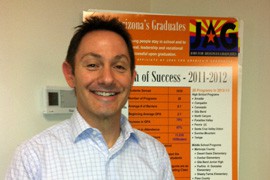Program keeps kids in school, helps them after graduation
TEMPE – Paola Carbajal, a senior at Tempe High School, has her future planned: attend cosmetology school, go to community college for a business degree and own a beauty salon.
Her path wasn’t always so clear.
“I was missing some credits from my freshman year,” Carbajal said.
Then there was her temper.
“I used to get angry very easily, and I’ve learned to calm my nerves,” she said. “There are a couple of people in class who are rude, and I’ve learned to just let them be.”
What makes the difference for Carbajal and about 1,000 other students each year is a program called Jobs for Arizona’s Graduates – JAG for short – that helps them stay in school and teaches how to get a job and enroll in college.
For Carbajal, the class gave her patience, she said. All students invited to take the course in their junior or senior years are taught academic and life skills through an emphasis on leadership curriculum, after-school projects and accountability to teachers and classmates.
“It’s fun, we do different community service activities and we learn a lot,” Carbajal said. “We stick together as a family.”
Twenty-six Arizona schools have JAG programs, which began in 1980. Then-Superintendent of Public Instruction Carolyn Warner was concerned about dropouts and heard of a Delaware program.
“I said OK, I have to have that program in Arizona,” she said. “It’s perfect.”
Arizona became the second state to adopt the model, and Warner has been on the board of Jobs for America’s Graduates, the national organization, more than 30 years.
“It saves lives and that’s the long and short of it,” she said. “These young people in many cases have had such a series of problems in their lives and barriers to success that it is shocking that they are still trying, but they are.”
The nonprofit receives corporate support, as well as foundation and government grants.
“The greatest challenge Arizona has is the greatest challenge we experience as a national network, and that’s simply always having to identify funding,” said Jim Koeninger, the executive vice president at Jobs for America’s Graduates.
Proof that JAG works, Koeninger said, is easy to see: participants graduate and gain employment at higher rates than average.
Students receive follow-up contact for 12 months to make sure they’re enrolled in college, have jobs or both, said Jason Moore, director of operations at JAG’s state office.
“It works because it’s relationship-based. We respect our students, and we empower them,” he said. “They get a taste of success, and they’re headed in the right direction.”
In fact, because JAG helps, districts have asked to expand it to middle schools and this year, for the first time, to an American Indian reservation, Moore said.
Students must face a minimum of five barriers – such as low grades, missing credits, legal issues or disciplinary challenges – to be considered for the program, according to Tanya Moulton, the JAG coordinator at Tempe High.
“I’ve had a number of kids who’ve been on probation, and I’ve had a number of kids who’ve been homeless,” Moulton said. “Currently, I have a young lady who’s not only a parent, but she’s also in the system. Mom’s in jail and dad is dead.”
Ava Bemer, in her fourth year as JAG coordinator at Tucson’s Sierra Middle School, said one of her students last year witnessed domestic violence and experienced homelessness, but because of JAG the girl made a decision to change her life. In high school now, the student earned a district award, a 4.0 grade average and is a cheerleader.
“By having the program in middle school, we’re providing kids the coping skills when they need them the most,” Bemer said. “They would fall between the cracks, and we would lose them. JAG is their support system.”
JAG survived the economic downturn, but at a cost: Eight programs were canceled and four moved to after-school clubs, which are not as intensive as the classes, but allow any student to participate, Moore said.
“We’re actually working with some districts to find creative solutions to deliver program services at lesser costs,” he said.
Many young people have their best academic year the first year they’re enrolled in JAG, he added.
“It’s not that they became any more intelligent in those nine months,” Moore said. “it’s that the barriers holding them back were addressed.”
That was true for Anthony Rivera, who’d been kicked out of school his freshman year. He said he wouldn’t be where he is today without JAG. Not only is he married with two children, he’s earned two master’s degrees, started a manufacturing business and runs a foundation.
“The basics stick with you forever – interviewing, follow-up – I still use those skills to this day in sales,” said Rivera, a 1986 Tolleson High graduate. “JAG is needed. It prepares you.”
One of JAG’s most notable graduates is state Rep. Anna Tovar, D-Tolleson, who was elected to the Arizona State Senate in November.
“JAG was monumental and life-changing for me. I knew I wanted to go to college, but being the first in my family, there were challenges,” she said. “JAG helped me believe in myself, and it sparked my interest in public service.”
Tovar now serves on JAG’s state board, so she said she’s come full circle.
“I see a lot of students like I was in high school,” she said. “They have so much potential.”
That includes students like Raija Holt, a Tempe High football player and second-year JAG participant who said he’d struggled with a bad attitude and needed credits for a couple of failed classes.
“My attitude changed a lot. I try to stay positive,” he said. “If you do good, it helps you in your regular life.”























